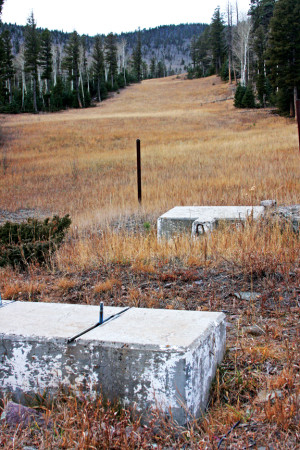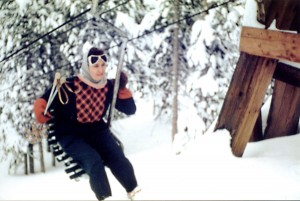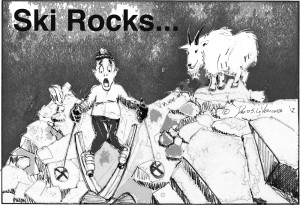By Hal Walter
Of all the holidays, Halloween is the one festivity that seems to turn out the entire Westcliffe community.
If it’s a school day the kids strike out as soon as the bell rings at 4 p.m., swarming in costume, many with parents in tow, to the downtown business district. Some of the adults wear costumes as well.
It amounts to a street party as the kids trick-or-treat the various shops and restaurants in the golden sunlight. For the grown-ups it’s a chance to socialize, and take time to actually talk with people you often only share waves with on the highway.
Over the years, the trick-or-treat routine has become less stressful. Our autistic son Harrison has gotten much better at the drill. In fact, this year in his No. 2 costume he often led the way in his little group of friends’ quest for candy.
It wasn’t always this way. I can still remember the first years when he’d follow the other kids into the establishments, and then quite often not find his way back out. Inevitably Mary or I would have to find our way through the sea of kids to find him wandering around in the store or sidetracked by something inside. A couple of times he passed right through the store, through the back office and into the alley.
Some social skills are still lacking. Rarely does Harrison greet the proprietor with a proper “trick-or-treat” or say “thank-you.” We’re still working on that. But at least he doesn’t vanish inside the store.
It’s become customary for one family to host a Halloween dinner party for kids and parents. Afterwards we take the kids out to hit up some of the neighboring homes for more candy.
Actually candy and autism are a really bad mix. It’s a concession we make to allow him the social experience. After Halloween is over we toss most of the sugary GMO-laden junk.
But this year Harrison definitely ate too much of the junk early. At the party there were a couple of disruptive outbursts. Afterward, when we went out in the dark for more trick-or-treating, he did what he had not done in years – at one doorstep he dashed past a woman holding a bowl of candy and disappeared inside. His friends crowded the doorway, and I stood on my toes trying to see what was going on inside. Suddenly he came rambling back out the front door.
At last another Halloween appeared to be over, and we were driving home from the festivities. At the point where our road turns off the highway there was another vehicle out ahead in the oncoming lane, moving very slowly. I judged its speed and distance, then went ahead and made the turn.
As I drove down the county road, I noticed in my rearview that the car had turned off the highway then stopped. About a mile later I noticed it was moving. As we rounded a bend it appeared the driver was flashing the brights.
I kept on driving. But the car drew closer and the headlights were clearly blinking more frantically. Here it was, Halloween night, and I wasn’t sure if it was someone needing help or whether it was some drunken crazy person, highway robber, a case of road-rage or whatever.
Finally we reached a place where there’s a sharp hill, a cattle guard and a driveway pullout on the right. As I passed over the cattle guard I cranked the car around in the driveway entrance, facing the driver of the following car and ready to roar away in the opposite direction if necessary.
What pulled up was an old man with Alzheimer’s, disoriented and lost. He first apologized for alarming us; but beyond that the discussion was muddled at best. He was aware enough to acknowledge he was lost and wanted help, but when I turned our car back around he apparently then thought he had been talking to two different people. He was 83 years old, driving a car around on Halloween, and didn’t seem to have a clue where he was or how to get home.
Mary went into nurse mode with evaluative questioning while I found the miracle of cell-phone service right there and called the sheriff’s office. The dispatcher seemed to know exactly who we’d found, and said his wife had reported him missing that evening. Could we wait with him until the deputies arrived?
Of course.
We tried to make conversation as we waited. He was incredibly polite. We asked about his career life, his family; despite his mental lapses he was still quite sharp about these matters. Meanwhile he seemed preoccupied about his oxygen bottles. Were they in the back seat? Yes, they’re right there I told him. He asked this two more times. Once he got out and checked the bottles for himself. Then he asked me about the bottles again. It was a strange mix of memory loss and obsessive-compulsive disorder, which I have struggled with most of my life and which I now am aware also often accompanies autism.
All the while Harrison sat in the back seat of our car, happily sorting through his Halloween candy. The bright but waning gibbous moon was low in the sky over the Wet Mountains and I stood outside between the cars, my son with autism in one and the old guy with Alzheimer’s in the other. One in his early years and the other surely in his final few. One with poor social skills and a near photographic memory, the other ultra-polite but unable to remember where his house is. The differences were striking, but some of the parallels were unnerving.
Finally the deputies arrived. The old guy asked if he could drive his car home, and one of the deputies politely told him they wanted to make sure he made it home safely. The old gent politely agreed.
They helped the old guy into the passenger seat and soon he was on his way.
Hal Walter writes and edits from the Wet Mountains. You can keep up with him regularly at his blog: www.hardscrabbletimes.com



